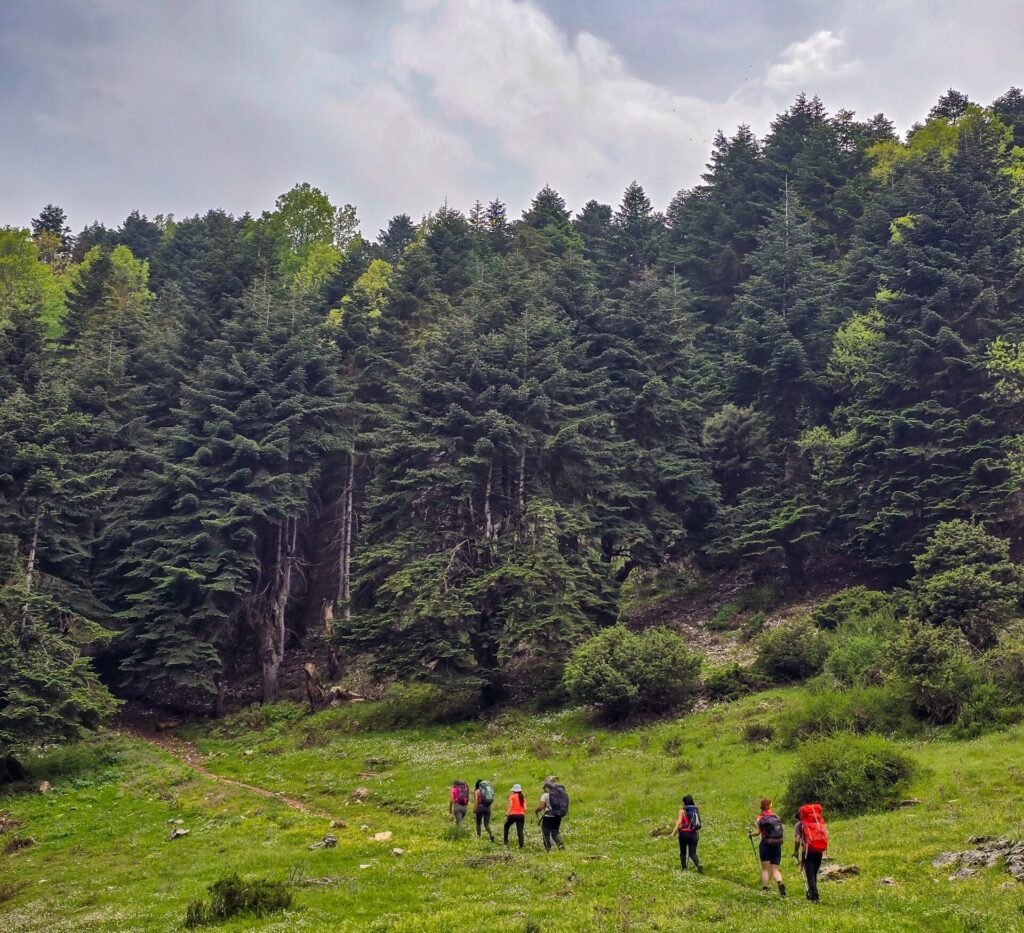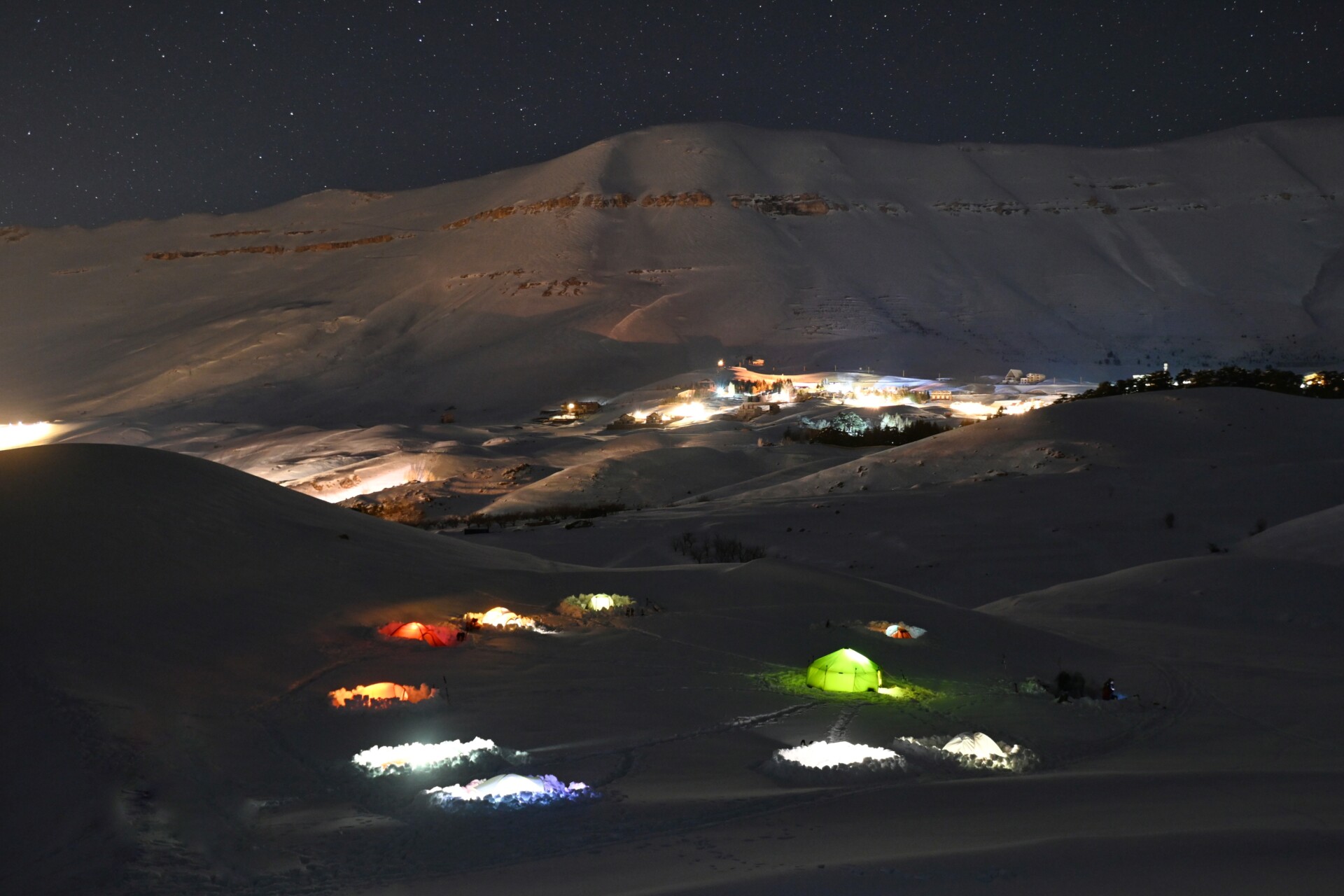Long before Lebanon’s mountains were mapped, myth gave them meaning. In the ancient Mesopotamian epic of Gilgamesh, the king of Uruk journeys to the cedar forests of Lebanon to fell the sacred trees to build his city.
In a violent clash with the forest guardian Humbaba, their battle shakes the earth, splitting the mountains into two ranges: Mount Lebanon in the west and the Anti-Lebanon in the east, with the fertile Bekaa Valley formed in between. It’s a tale that mountain leader Gilbert Moukheiber weaves for clients while traversing these ranges, sculpted by the collision of continental plates.
Myths evolve and landscapes shift — and so too does Lebanon’s political reality. While the nation works toward domestic stability amid conflict spilling over its borders and dwindling international visitors, adventure travel has emerged as the fastest-growing tourism sector globally.
New hiking trails retracing shepherd routes in the Anti-Lebanon mountains, along the volatile border with Syria, could provide a path to recovery, attracting tourism, reconnecting communities and reviving the economy.

Based in Beit Mery, in the hills east of Beirut, Moukheiber has spent over 30 years in Lebanon’s ranges and founded his guiding company 33North in 1996. As tourism plummeted during the COVID-19 pandemic and Lebanon’s economic crisis worsened in 2020, he imagined a new long-distance mountain trail network spanning the country’s less-traveled north and east. “I wanted to offer something to Lebanon personally,” he told New Lines.
The resulting Boukaat Loubnan Trails (BLT) attract tourism, while also serving as a peace-building and economy-boosting project for people living in deprivation across 50 fragmented communities. Moukheiber self-financed the trail development but received some funding from the European Union for signage, a website and guesthouse renovation. “International donors are definitely reluctant to support this area,” he said.
Spanning 250 miles, the network consists of three trails. The Anti-Lebanon Trail, which crosses former Islamic State group battlegrounds and hideouts, is billed as a “dark tourism” attraction — a term describing places associated with tragedy or conflict. The Mount Hermon Tour Trail, inspired by the Tour du Mont Blanc in the Alps, traces the foothills of the symbolic peak and tours Roman temples in southeastern Lebanon. The North Bekaa Trail in the northeastern borderlands features juniper forests and the open plains of the Bekaa Valley.
Five years in the making, the BLT promotes sustainable, rural ecotourism in remote villages and towns, including Ras Baalbek, al-Qaa, Hermel, Rashaya and Akoura, alongside cultural and religious sites. Twice a year, hikers join shepherds practicing transhumance (“al-terhal” in Arabic), the seasonal ritual of moving livestock between highland and lowland pastures, recognized as intangible cultural heritage by UNESCO. “They milk the goats, they teach us how to make bread, labneh and cheese,” Moukheiber said. “It takes us back to their roots.”
In the Bekaa plains and beyond, shepherds sell food while residents benefit from home stays, winery visits and tour guiding. “We work with the locals,” Moukheiber said. “They are the sons of the land.”
Before Ras Baalbek became part of the BLT, local forum member Georges Fadel described it as a “forgotten village” in the Anti-Lebanon. “Now, the trail attracts visitors and boosts the local economy through small businesses, while fostering environmental awareness and community pride,” he said.
The new eastern network mirrors the 280-mile Lebanon Mountain Trail (LMT), which runs north to south along the Mount Lebanon range in the west. The LMT launched in 2007 with Moukheiber as a founding member and received assistance from the U.S. Agency for International Development (USAID) to encourage “ecotourism as a postconflict recreational industry.”
Nearly 20 years later, the ongoing Israel-Hezbollah conflict presents a new challenge to tourism in Lebanon — and to the new trails. As fault lines reopened, Lebanon welcomed just 2.8 million foreign visitors in 2024, down from 3.5 million in 2023. In February 2024, the Bekaa Valley, where Hezbollah was founded, became a battleground once again, rendering some BLT routes off-limits.
To date, all of Moukheiber’s guided clients on the BLT have been Lebanese. His current focus is supporting domestic tourism while foreign travel advisories remain in place.
“Domestic tourism has always played a crucial role in Lebanon in times of crisis,” he said. “We have so many opportunities, which make Lebanon a year-round destination, but when it comes to security, it all stops.” In Moukheiber’s experience, some tourists hold a misconception about Lebanon. “They think it’s a desert country, but there is no desert and 80% of the terrain is mountainous,” he said. “We have to convince people that Lebanon has mountains.”
Other Middle Eastern countries, including Saudi Arabia and the United Arab Emirates, are investing billions of dollars in state-supported adventure tourism via projects including NEOM, AlUla, Soudah Peaks and the Jebel Jais resort. The Gulf adventure tourism market is expected to grow from an estimated $18.6 billion in 2025 to $71.4 billion by 2035. Meanwhile, Moukheiber’s grassroots initiative raises the question of whether a community-led model in Lebanon can reach proportional success.
The track record of the older LMT provides a template for what the BLT could achieve. In April 2019, through-hikers spent over $100,000 in local villages along the LMT. The project was modelled on the 2,200-mile Appalachian Trail in the United States, which attracts 3 million visitors annually, collectively spending between $125 million and $168 million.
Following a promising surge in tourism and outdoor activity in 2023, as the pandemic’s impact waned, Lebanon’s former minister of tourism, Walid Nassar, outlined the rising potential of adventure tourism. “In the past two to three years, hiking trails in Lebanon have become an emerging trend,” he said. “They are playing a crucial role in our tourism sector, encouraging both local and international tourists to explore diverse landscapes and discover lesser-known regions across the country.”
The optimism was short-lived. In 2024, renewed conflict led to dwindling visitors and an estimated $1.3 billion loss in tourism receipts, according to the World Bank, rendering an uphill economic struggle even steeper.
Yet under more peaceful conditions, the BLT presents a timely opportunity, aligning with global trends favoring “slow tourism” and authentic, immersive travel. Similar long-distance hiking networks have emerged elsewhere in the Middle East over the last decade, including the Bedouin routes of the Jordan Trail, the Wadi Rum Trail, the Palestinian Heritage Trail and the pilgrimage paths of the Zagros Mountain Trail in the Kurdistan Region of Iraq.
In a parallel effort to the BLT, a nascent project named Caminos Lebanon — inspired by Spain’s Camino de Santiago — aims to revitalize Christian religious tourism. In March, the Association of Pilgrimages in Lebanon announced plans for a nationwide network of four routes, spanning 24 shrines and 6,000 Christian and Muslim spiritual sites.
This expanding web of Middle Eastern hiking trails also speaks to a broader trend of tourism as diplomacy or postconflict “narrative repair.” Moukheiber hopes to extend the BLT internationally, if and when the region stabilizes, along the lines of the Abraham Path Initiative, which connects trails following in the footsteps of the biblical Abraham across Jordan, Israel, Palestine and Turkey to promote cross-cultural dialogue and benefit communities. “The BLT has huge potential to connect physically with its neighboring countries, because it is a border trail,” he said.
For Lebanese hikers, discovering these mountain regions means engaging with their country’s rich human history and heritage. Rana Abi Warde lives in the Keserwan district, northeast of Beirut. She left Lebanon at the age of 18 and returned in 2017 after 30 years abroad. Joining her first hiking trip from Tannourine to Faraya in 2018 on the LMT opened her eyes to her home landscape.
“I discovered another Lebanon,” she said. “I was a tourist in my own country. The places were new, the food was tastier, with dishes I had never heard of, and people were so friendly.” Having spent the COVID-19 lockdowns in Canada, Abi Warde returned home. “I missed my beloved country, the colorful sunsets and our majestic mountains,” she said.
In 2020, Abi Warde was among the first to hike parts of the BLT network on a five-day trek in the northeast from Ras Baalbek to Akoura. Walking along winding rocky paths surrounded by juniper trees, the group traced routes shaped by the passage of hundreds of thousands of feet over millennia, “from animal hooves to human boots,” Abi Warde said.
This route is currently off-limits because of the conflict. “Hopefully, we’ll soon be able to hike all of the sections,” she added. Abi Warde has since hiked extensively abroad and believes that Lebanon’s trails should rank among the world’s best.
Once known as “the Switzerland of the Middle East” for its snowy peaks, ski resorts and secure banking, Lebanon attracted wealthy tourists in the 1950s and ‘60s, as well as growing numbers of hikers. After the civil war of 1975-90, Lebanon’s trails gained footfall as landmines were cleared. The launch of the Lebanon Mountain Trail in 2007 marked the creation of a mountain tourism culture in Lebanon, involving local guides and guesthouses. “It was the beginning of a new era,” Moukheiber said.
Up until 2019, Lebanon and its mountainous landscapes attracted increasing numbers of foreign tourists, but the mass protests of October 2019, followed by the 2020 Beirut port explosion, the pandemic and the Israel-Hezbollah conflict that broke out in October 2023 combined to cross Lebanon off the tourism map, as travel advisories colored it red.
In August 2023, shortly before the outbreak of the Israel-Gaza war, a British tourist, Tom de Csilléry, spent three weeks in Lebanon, hiking the LMT in the Qadisha Valley and rock climbing in Tannourine. “We felt safe and incredibly welcome, especially in the mountains,” he said. “It was devastating to see how the economic crisis had crippled the country and driven up prices, yet everyone we met was generous, hospitable and excited to see tourists.”
“We opened the trail in Lebanon’s most challenging period,” Moukheiber said. “It will take a lot of effort to encourage foreign tourists to visit [again], but it’s now going in the right direction.”
On the current state of travel in Lebanon, the Ministry of Tourism — headed by new Minister Laura Lahoud — told New Lines: “We are very optimistic about tourism in Lebanon this year. We are anticipating a significant influx of visitors, including both tourists and expatriates, as there is a strong desire for people to experience Lebanon.” Reflecting this optimism, the World Bank estimates a projected real GDP growth in Lebanon of 4.7% in 2025, citing the new government and recovering tourism.
Once foreign footfall increases, Moukheiber hopes that the BLT could eventually become as famous as the Appalachian Trail and the Tour du Mont Blanc.
“If you come to Lebanon and don’t go to the mountains, you miss the new face of the country,” Moukheiber said. “This is where you discover our hospitality and food — people welcoming you into their homes. For me, this is the real Lebanon.”
Step by step, visitors retracing these ancient hiking routes through Lebanon’s history, landscape and legends can help to put tourism back on the map — and, like the mythical figures long before them, they could move mountains for Lebanon in the process.
“Spotlight” is a newsletter about underreported cultural trends and news from around the world, emailed to subscribers twice a week. Sign up here.



